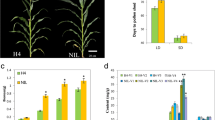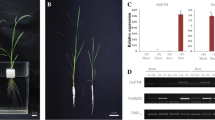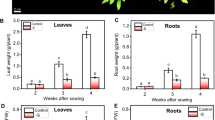Abstract
Sugar is an important resource for energy generation and developmental regulation in plants, and sucrose starvation causes enormous changes in cellular morphology, enzyme activities and gene expression. Genome-wide gene expression profiling provides a comprehensive knowledge of gene expression under nutrient depletion and senescence; however, that of a monocot model plant, rice, under sucrose depletion is still under investigation. Here, the time-course monitoring of gene expression profiles in sucrose-starved rice (Oryza sativa cv Tainung67) suspension cells was investigated by 21495 probes contained in Agilent rice chip. In sucrose-starved cells, the induced vacuolar biogenesis coincided with significantly upregulated transcripts of H+-pyrophosphatase, δ-TIP, one putative α-TIP, several vacuolar proteases and proteinase inhibitors, and one OsATG3. To survey the overall metabolic adaptations under sucrose depletion, the genes with significantly altered expression level were incorporated into multiple metabolic pathways. Most genes encoding enzymes involved in biosynthesis and degradation pathways of various macromolecules were comprehensively down- and upregulated, respectively, with sucrose starvation. Transcriptional regulation of gene expression is important for physiological adaptations to environmental stress, and many transcription factors, including bZIPs, NACs, and WRKY, showed significant increase in transcriptional level under sucrose starvation. Concurrently, statistical analysis revealed that their corresponding consensus cis-elements, such as ABA-responsive element, CACG, ACI, ACII and CTTATCC, were frequently found in the promoter regions of many sucrose starvation-upregulated genes. Particle bombardment-mediated and luciferase activity-based transient promoter assays revealed the CTTATCC, derived form TATCCA, and the AC motifs to be promising sucrose-starvation responsive activators in rice suspension cells.








Similar content being viewed by others
References
Ahmed SU, Rojo E, Kovaleva V et al (2000) The plant vacuolar sorting receptor AtELP is involved in transport of NH(2)-terminal propeptide-containing vacuolar proteins in Arabidopsis thaliana. J Cell Biol 149(7):1335–1344
Aubert S, Alban C, Bligny R et al (1996a) Induction of β-methylcrotonyl-coenzyme A carboxylase in higher plant cells during carbohydrate starvation: evidence for a role of MCCase in leucine catabolism. FEBS Lett 383(3):175–180
Aubert S, Gout E, Bligny R et al (1996b) Ultrastructural and biochemical characterization of autophagy in higher plant cells subjected to carbon deprivation: control by the supply of mitochondria with respiratory substrates. J Cell Biol 133(6):1251–1263
Brouquisse R, Gaudillere JP, Raymond P (1998) Induction of a carbon-starvation-related proteolysis in whole maize plants submitted to Light/Dark cycles and to extended darkness. Plant Physiol 117(4):1281–1291
Brouquisse R, James F, Pradet A et al (1992a) Asparagine metabolism and nitrogen distribution during protein degradation in sugar-starved maize root tips. Planta 188:384–395
Brouquisse R, James F, Pradet A et al (1992b) Sugar levels modulate differential expression of maize sucrose synthase genes. Plant Cell 4:59–69
Brouquisse R, James F, Raymond P et al (1991) Study of glucose starvation in excised maize root tips. Plant Physiol 96:619–626
Buchanan-Wollaston V, Page T, Harrison E et al (2005) Comparative transcriptome analysis reveals significant differences in gene expression and signalling pathways between developmental and dark/starvation-induced senescence in Arabidopsis. Plant J 42(4):567–585
Busch W, Wunderlich M, Schoffl F (2005) Identification of novel heat shock factor-dependent genes and biochemical pathways in Arabidopsis thaliana. Plant J 41(1):1–14
Casaretto J, Ho TH (2003) The transcription factors HvABI5 and HvVP1 are required for the abscisic acid induction of gene expression in barley aleurone cells. Plant Cell 15(1):271–284
Chen MH, Liu LF, Chen YR et al (1994) Expression of α-amylases, carbohydrate metabolism, and autophagy in cultured rice cells is coordinately regulated by sugar nutrient. Plant J 6(5):625–636
Collinge M, Boller T (2001) Differential induction of two potato genes, Stprx2 and StNAC, in response to infection by Phytophthora infestans and to wounding. Plant Mol Biol 46(5):521–529
Contento AL, Kim SJ, Bassham DC (2004) Transcriptome profiling of the response of Arabidopsis suspension culture cells to Suc starvation. Plant Physiol 135(4):2330–2347
Dennis PB, Jaeschke A, Saitoh M et al (2001) Mammalian TOR: a homeostatic ATP sensor. Science 294(5544):1102–1105
Deprost D, Truong HN, Robaglia C et al (2005) An Arabidopsis homolog of RAPTOR/KOG1 is essential for early embryo development. Biochem Biophys Res Commun 326(4):844–850
Dieuaide M, Brouquisse R, Pradet A et al (1992) Increased fatty acid beta-oxidation after glucose starvation in maize root tips. Plant Physiol 99:595–600
Dieuaide M, Couee I, Pradet A et al (1993) Effects of glucose starvation on the oxidation of fatty acids by maize root tip mitochondria and peroxisomes: evidence for mitochondrial fatty acid beta-oxidation and acyl-CoA dehydrogenase activity in a higher plant. Biochem J 296( Pt 1):199–207
Doelling JH, Walker JM, Friedman EM et al (2002) The APG8/12-activating enzyme APG7 is required for proper nutrient recycling and senescence in Arabidopsis thaliana. J Biol Chem 277(36):33105–33114
Fujiki Y, Yoshikawa Y, Sato T et al (2001) Dark-inducible genes from Arabidopsis thaliana are associated with leaf senescence and repressed by sugars. Physiol Plant 111(3):345–352
Fujita M, Fujita Y, Maruyama K et al (2004) A dehydration-induced NAC protein, RD26, is involved in a novel ABA-dependent stress-signaling pathway. Plant J 39(6):863–876
Graham IA, Denby KJ, Leaver CJ (1994) Carbon catabolite repression regulates glyoxylate cycle gene expression in cucumber. Plant Cell 6(5):761–772
Hanaoka H, Noda T, Shirano Y et al (2002) Leaf senescence and starvation-induced chlorosis are accelerated by the disruption of an Arabidopsis autophagy gene. Plant Physiol 129(3):1181–1193
Hatton D, Sablowski R, Yung MH et al (1995) Two classes of cis sequences contribute to tissue-specific expression of a PAL2 promoter in transgenic tobacco. Plant J 7(6):859–876
Hay N, Sonenberg N (2004) Upstream and downstream of mTOR. Genes Dev 18(16):1926–1945
Hegedus D, Yu M, Baldwin D et al (2003) Molecular characterization of Brassica napus NAC domain transcriptional activators induced in response to biotic and abiotic stress. Plant Mol Biol 53(3):383–397
Hobo T, Asada M, Kowyama Y et al (1999a) ACGT-containing abscisic acid response element (ABRE) and coupling element 3 (CE3) are functionally equivalent. Plant J 19(6):679–689
Hobo T, Kowyama Y, Hattori T (1999b) A bZIP factor, TRAB1, interacts with VP1 and mediates abscisic acid-induced transcription. Proc Natl Acad Sci USA 96(26):15348–15353
Ishizaki K, Larson TR, Schauer N et al (2005) The critical role of Arabidopsis electron-transfer flavoprotein:ubiquinone oxidoreductase during dark-induced starvation. Plant Cell 17(9):2587–600
Izawa T, Foster R, Chua NH (1993) Plant bZIP protein DNA binding specificity. J Mol Biol 230(4):1131–1144
Jauh GY, Phillips TE, Rogers JC (1999) Tonoplast intrinsic protein isoforms as markers for vacuolar functions. Plant Cell 11(10):1867–1882
Ketelaar T, Voss C, Dimmock SA et al (2004) Arabidopsis homologues of the autophagy protein Atg8 are a novel family of microtubule binding proteins. FEBS Lett 567(2–3):302–306
Kim S, Kang JY, Cho DI et al (2004) ABF2, an ABRE-binding bZIP factor, is an essential component of glucose signaling and its overexpression affects multiple stress tolerance. Plant J 40(1):75–87
Kinoshita T, Yamada K, Hiraiwa N et al (1999) Vacuolar processing enzyme is up-regulated in the lytic vacuoles of vegetative tissues during senescence and under various stressed conditions. Plant J 19(1):43–53
Klionsky DJ (2004) Autophagy: an overview. In: Klionsky DJ (ed) Autophagy. Landes Bioscience, Georgetown, pp 1–9
Koch KE (1996) Carbohydrate-modulated gene expression in plants. Annu Rev Plant Physiol Plant Mol Biol 47:509–540
Laloi C, Mestres-Ortega D, Marco Y et al (2004) The Arabidopsis cytosolic thioredoxin h5 gene induction by oxidative stress and its W-box-mediated response to pathogen elicitor. Plant Physiol 134(3):1006–1016
Lan L, Li M, Lai Y et al (2005) Microarray analysis reveals similarities and variations in genetic programs controlling pollination/fertilization and stress responses in rice (Oryza sativa L.). Plant Mol Biol 59(1):151–164
Lee JH, Hubel A, Schoffl F (1995) Derepression of the activity of genetically engineered heat shock factor causes constitutive synthesis of heat shock proteins and increased thermotolerance in transgenic Arabidopsis. Plant J 8(4):603–612
Lee YC, Lu CA, Chen PW et al (2003) An ABA-responsive bZIP protein, OsBZ8, mediates sugar repression of α-amylase gene expression. Physiol Plantarum 119:78–86
Li CY, Weiss D, Goldschmidt EE (2003) Effects of carbohydrate starvation on gene expression in citrus root. Planta 217(1):11–20
Li J, Brader G, Palva ET (2004) The WRKY70 transcription factor: a node of convergence for jasmonate-mediated and salicylate-mediated signals in plant defense. Plant Cell 16(2):319–331
Lin JF, Wu SH (2004) Molecular events in senescing Arabidopsis leaves. Plant J 39(4):612–628
Lu CA, Ho TH, Ho SL et al (2002) Three novel MYB proteins with one DNA binding repeat mediate sugar and hormone regulation of α-amylase gene expression. Plant Cell 14(8):1963–1980
Lu CA, Lim EK, Yu SM (1998) Sugar response sequence in the promoter of a rice α-amylase gene serves as a transcriptional enhancer. J Biol Chem 273(17):10120–10131
Mahfouz MM, Kim S, Delauney AJ et al (2006) Arabidopsis TARGET OF RAPAMYCIN interacts with RAPTOR, which regulates the activity of S6 kinase in response to osmotic stress signals. Plant Cell 18(2):477–490
Mare C, Mazzucotelli E, Crosatti C et al (2004) Hv-WRKY38: a new transcription factor involved in cold- and drought-response in barley. Plant Mol Biol 55(3):399–416
Menand B, Desnos T, Nussaume L et al (2002) Expression and disruption of the Arabidopsis TOR (target of rapamycin) gene. Proc Natl Acad Sci USA 99(9):6422–6427
Miao Y, Laun T, Zimmermann P et al (2004) Targets of the WRKY53 transcription factor and its role during leaf senescence in Arabidopsis. Plant Mol Biol 55(6):853–867
Moriyasu Y, Hattori M, Jauh GY et al (2003) Alpha tonoplast intrinsic protein is specifically associated with vacuole membrane involved in an autophagic process. Plant Cell Physiol 44(8):795–802
Moriyasu Y, Klionsky DJ (2004) Autophagy in plant. In: Klionsky DJ (ed) Autophagy. Landes Bioscience, Georgetown, pp 208–215
Moriyasu Y, Ohsumi Y (1996) Autophagy in tobacco suspension-cultured cells in response to sucrose starvation. Plant Physiol 111(4):1233–1241
Murashige T, Skoog F (1962) A revised medium for rapid growth and bioassays with tobacco tissue culture. Physiol Plant 15:473–479
Noda T, Ohsumi Y (2004) Macroautophagy in yeast. In: Klionsky DJ (ed) Autophagy. Landes Bioscience, Georgetown, pp 70–83
Olsen AN, Ernst HA, Leggio LL et al (2005) NAC transcription factors: structurally distinct, functionally diverse. Trends Plant Sci 10(2):79–87
Panchuk II, Volkov RA, Schoffl F (2002) Heat stress- and heat shock transcription factor-dependent expression and activity of ascorbate peroxidase in Arabidopsis. Plant Physiol 129(2):838–853
Plaxton WC (1996) The organization and regulation of plant glycolysis. Annu Rev Plant Physiol Plant Mol Biol 47:185–214
Prandl R, Hinderhofer K, Eggers-Schumacher G et al (1998) HSF3, a new heat shock factor from Arabidopsis thaliana, derepresses the heat shock response and confers thermotolerance when overexpressed in transgenic plants. Mol Gen Genet 258(3):269–278
Project IRGS (2005) The map-based sequence of the rice genome. Nature 436(7052):793–800
Qu LJ, Chen J, Liu M et al (2003) Molecular cloning and functional analysis of a novel type of Bowman-Birk inhibitor gene family in rice. Plant Physiol 133(2):560–570
Ren T, Qu F, Morris TJ (2000) HRT gene function requires interaction between a NAC protein and viral capsid protein to confer resistance to turnip crinkle virus. Plant Cell 12(10):1917–1926
Rolland F, Moore B, Sheen J (2002) Sugar sensing and signaling in plants. Plant Cell 14(Suppl):S185–S205
Rose TL, Bonneau L, Der C et al (2006) Starvation-induced expression of autophagy-related genes in Arabidopsis. Biol Cell 98(1):53–67
Ryan CA (1990) Proteinase inhibitors in plants: genes for improving defenses against insects and pathogens. Annu Rev phytophathol 28:425–449
Sablowski RW, Meyerowitz EM (1998) A homolog of NO APICAL MERISTEM is an immediate target of the floral homeotic genes APETALA3/PISTILLATA. Cell 92(1):93–103
Sablowski RW, Moyano E, Culianez-Macia FA et al (1994) A flower-specific Myb protein activates transcription of phenylpropanoid biosynthetic genes. Embo J 13(1):128–137
Sambrook JE, Fritsch ET, Maniatis R (1989) Molecular cloning: A laboratory manual, Cold Spring Harbor Laboratory, New York
Scheible WR, Morcuende R, Czechowski T et al (2004) Genome-wide reprogramming of primary and secondary metabolism, protein synthesis, cellular growth processes, and the regulatory infrastructure of Arabidopsis in response to nitrogen. Plant Physiol 136(1):2483–2499
Schluepmann H, Pellny T, van Dijken A et al (2003) Trehalose 6-phosphate is indispensable for carbohydrate utilization and growth in Arabidopsis thaliana. Proc Natl Acad Sci USA 100(11):6849–6854
Schmelzle T, Hall MN (2000) TOR, a central controller of cell growth. Cell 103(2):253–262
Schuster J, Binder S (2005) The mitochondrial branched-chain aminotransferase (AtBCAT-1) is capable to initiate degradation of leucine, isoleucine and valine in almost all tissues in Arabidopsis thaliana. Plant Mol Biol 57(2):241–254
Shen Q, Ho T. H (1997) Promoter switches specific for abscisic acid (ABA)-induced gene expression in cereals. Physiol. Plantarum 101:653–664
Sheu JJ, Yu TS, Tong WF et al (1996) Carbohydrate starvation stimulates differential expression of rice α-amylase genes that is modulated through complicated transcriptional and posttranscriptional processes. J Biol Chem 271(43):26998–27004
Slavikova S, Shy G, Yao Y et al (2005) The autophagy-associated Atg8 gene family operates both under favourable growth conditions and under starvation stresses in Arabidopsis plants. J Exp Bot 56(421):2839–2849
Sodek L, Wilson CM (1973) Metabolism of lysine and leucine derived from storage protein during the germination of maize. Biochim Biophys Acta 304(2):353–362
Souer E, van Houwelingen A, Kloos D et al (1996) The No Apical Meristem gene of Petunia is required for pattern formation in embryos and flowers and is expressed at meristem and primordia boundaries. Cell 85(2):159–170
Stewart CR, Beever H (1967) Gluconeogenesis from amino acids in germinating castor bean endosperm and its role in transport to the embryo. Plant Physiol 42:1587–1595
Takada S, Hibara K, Ishida T et al (2001) The CUP-SHAPED COTYLEDON1 gene of Arabidopsis regulates shoot apical meristem formation. Development 128(7):1127–1135
Tassi F, Maestri E, Restivo FM et al (1992) The effects of carbon starvation on cellular metabolism and protein and RNA synthesis in Gerbera callus cultures. Plant Sci 83:127–136
Thimm O, Blasing O, Gibon Y et al (2004) MAPMAN: a user-driven tool to display genomics data sets onto diagrams of metabolic pathways and other biological processes. Plant J 37(6):914–939
Thompson AR, Doelling JH, Suttangkakul A et al (2005) Autophagic nutrient recycling in Arabidopsis directed by the ATG8 and ATG12 conjugation pathways. Plant Physiol 138(4):2097–2110
Tran LS, Nakashima K, Sakuma Y et al (2004) Isolation and functional analysis of Arabidopsis stress-inducible NAC transcription factors that bind to a drought-responsive cis-element in the early responsive to dehydration stress 1 promoter. Plant Cell 16(9):2481–2498
Tymowska-Lalanne Z, Kreis M (1998) Expression of the Arabidopsis thaliana invertase gene family. Planta 207(2):259–265
Umemura T, Perata P, Futsuhara Y et al (1998) Sugar sensing and α-amylase gene repression in rice embryos. Planta 204(4): 420–428
Vroemen CW, Mordhorst AP, Albrecht C et al (2003) The CUP-SHAPED COTYLEDON3 gene is required for boundary and shoot meristem formation in Arabidopsis. Plant Cell 15(7):1563–1577
Wang Z, Liang Y, Li C et al (2005) Microarray analysis of gene expression involved in anther development in rice (Oryza sativa L.). Plant Mol Biol 58(5):721–737
Xie Q, Frugis G, Colgan D et al (2000) Arabidopsis NAC1 transduces auxin signal downstream of TIR1 to promote lateral root development. Genes Dev 14(23):3024–3036
Xie Q, Sanz-Burgos AP, Guo H et al (1999) GRAB proteins, novel members of the NAC domain family, isolated by their interaction with a geminivirus protein. Plant Mol Biol 39(4):647–656
Yi K, Wu Z, Zhou J et al (2005) OsPTF1, a novel transcription factor involved in tolerance to phosphate starvation in rice. Plant Physiol 138(4):2087–2096
Yoshimoto K, Hanaoka H, Sato S et al (2004) Processing of ATG8s, ubiquitin-like proteins, and their deconjugation by ATG4s are essential for plant autophagy. Plant Cell 16(11):2967–2983
Yu SM (1999a) Cellular and genetic responses of plants to sugar starvation. Plant Physiol 121(3):687–693
Yu SM (1999b) Regulation of α-amylase gene expression. In: Shimamoto K (ed) Molecular biology of rice, Springer, Tokyo, pp 161–178
Yu SM, Kuo YH, Sheu G et al (1991) Metabolic derepression of α-amylase gene expression in suspension-cultured cells of rice. J Biol Chem 266(31):21131–21137
Zhang W, Ruan J, Ho TH et al (2005) Cis-regulatory element based targeted gene finding: genome-wide identification of abscisic acid- and abiotic stress-responsive genes in Arabidopsis thaliana. Bioinformatics 21(14):3074–3081
Acknowledgements
We thank Drs. Tuan-hua Ho and Shu-Hsing Wu for critically reading and providing valuable comments on the manuscript. We also thank Ms. Shu-Jen Chou, microarray facility, and Dr. Wann-Neng Jane, cell biology core facility, Institute of Plant and Microbial Biology, Academia Sinica, for technical support with the microarray and TEM experiments. This research is supported by research grants from Academia Sinica (Taiwan), National Science Council (NSC 93-2311-B-001-010- and 94-2311-B-001 -054 -, Taiwan), and the Li Foundation (USA) to G.-Y. Jauh.
Author information
Authors and Affiliations
Corresponding author
Rights and permissions
About this article
Cite this article
Wang, HJ., Wan, AR., Hsu, CM. et al. Transcriptomic adaptations in rice suspension cells under sucrose starvation. Plant Mol Biol 63, 441–463 (2007). https://doi.org/10.1007/s11103-006-9100-4
Received:
Accepted:
Published:
Issue Date:
DOI: https://doi.org/10.1007/s11103-006-9100-4




